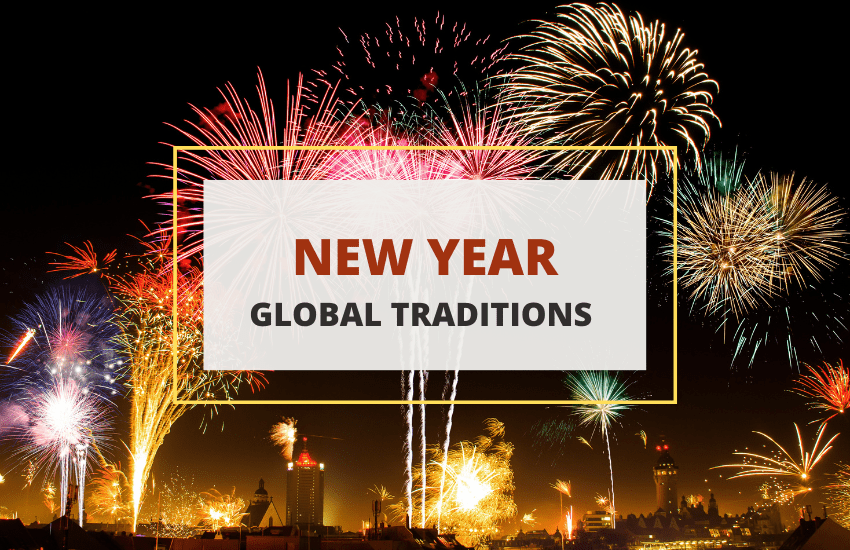
Table of Contents
Do you know how people in other countries celebrate the New Year? It is interesting to learn about the different traditions that people observe around the world.
Each country has its own traditions and customs when it comes to celebrating the New Year. Some people participate in elaborate ceremonies, while others enjoy quiet gatherings with family and friends.
No matter how you choose to ring in the New Year, there is sure to be a tradition somewhere that will fascinate you. In this article, we will explore some of the most interesting New Year traditions from around the world.
Traditions
Norway: Celebrating with a towering cake.

One of the unique New Year traditions comes from Norway, where people bake a giant cake called a kransekake.
This towering dessert has at least 18 layers and is made up of rings of almond-flavored cake, stacked on top of each other and decorated with icing, flowers, and Norwegian flags.
The kransekake is said to bring good luck in the coming year, and it is often served at weddings and other special occasions. It is said that the taller the cake, the more luck you will have in the new year.
Colombia: Placing three potatoes under the bed.
This may sound weird, but in Colombia, it is tradition to place three potatoes under the bed on New Year’s Eve. It is said that if you do this, you will have a prosperous year ahead.
One potato is peeled, one is half-peeled, and the third one is put as it is. These potatoes symbolize good fortune, financial struggle, or a mix of both.
Families, friends, and loved ones often gather around the bed and countdown to midnight, where they try to grab the potato with one eye closed.
Ireland: Special fruit cake.

In Ireland, it is tradition to bake a special type of fruitcake called barmbrack. This cake is filled with raisins, sultanas, and candied peel, and it is often served with tea.
It is said that you can tell your future by finding objects hidden in the cake. For example, if you find a coin, it means you will be prosperous in the coming year. If you find a ring, it means you will soon be married. And if you find a piece of cloth, it means you will have bad luck.
Greece: Hanging an onion outside the door
Onion is one of the most important kitchen staples in Greece. The Greeks believe that it brings you good luck if you hang an onion outside your door on New Year’s Eve.
It is said that the onion will absorb all the negativity from the past year, and when you cut it open on New Year’s Day, all the bad luck will be gone.
According to the Greeks, onions symbolize fertility and growth, because of its ability to sprout on its own, which is why they believe that it will bring you good luck in the coming year.
Mexico: Giving the gift of homemade tamales.

Tamales are traditional Mexican dishes made of corn dough, filled with meat, vegetables, or fruits, and wrapped in a corn husk or banana leaf. They are often served during holidays and special occasions.
In Mexico, it is tradition to give tamales as gifts on New Year’s Eve. The recipient of the tamales is said to have good luck in the coming year. This tradition is also practiced in other parts of Central and South America. This dish is served with a traditional Mexican soup called ‘Menudo,’ made from a cow’s stomach.
Philippines: Serving 12 round fruits.
Round fruits like plums, grapes, and apples represent good luck in the Philippines. Because of their round shape, they resemble coins, representing prosperity.
That is why it is tradition to serve 12 round fruits on the New Year’s Eve dinner table. The fruits are often placed in a basket or a bowl, and they are said to symbolize the 12 months of the year. This tradition is believed to bring good health and fortune in the coming year.
Canada: Going ice fishing.

One of unique New Year traditions in Canada is going ice fishing. This activity is often done with family and friends, and it is said to bring good luck in the coming year.
Ice fishing is a popular winter sport in Canada, and it involves drilling a hole in the ice and catching fish through the hole. The fish are then cooked and eaten on the spot.
This tradition is often combined with other New Year’s Eve activities like watching fireworks or attending parties. Canadians rent cooking equipment and heated tents to make this activity more comfortable.
Denmark: Throwing old plates.
It may sound a little counter-productive to break plates, but in Denmark, chucking plates is said to bring good luck to your friends and family. According to the locals, the more broken plates you accumulate on your doorstep, the better.
This tradition started in the 19th century when people would throw plates and dishes at the homes of their friends and loved ones as a way of showing affection. Today, people still do this, but they use old plates that they don’t need anymore. This tradition is also practiced in other parts of Scandinavia.
Haiti: Sharing soup joumou.

Soup joumou is a traditional Haitian soup made from squash. It is often served on special occasions, and it is said to bring good luck. Haitians believe that this soup has the power to chase away bad spirits.
hat is why it is tradition to share soup joumou with family and friends on New Year’s Eve. This soup is also eaten on Independence Day and Christmas. The tradition of eating soup joumou on New Year’s Eve started after Haiti gained independence from France in 1804.
France: Feasting with Champagne.
France is a country known for its wine, and it is no surprise that one of its New Year traditions involves drinking Champagne.
On New Year’s Eve, it is tradition to feast on a meal of lobster, oysters, and other seafood, followed by a dessert of rum-soaked cake. This tradition is said to bring good luck in the coming year.
The French believed that eating seafood with champagne would bring them wealth and fortune. And what better way to wash down a meal than with some bubbly Champagne?
Japan: Eating soba noodles.

In Japan, it is a tradition to eat soba noodles on New Year’s Eve. This dish is made from buckwheat flour, and it is said to bring good luck in the coming year. The Japanese believe that the long noodles represent a long life.
That is why it is tradition to eat them on New Year’s Eve. Soba noodles are often served with a dipping sauce, and they can be eaten hot or cold. This dish is also eaten on other special occasions like birthdays and weddings.
Spain: Eating twelve grapes.
In Spain, it is tradition to eat twelve grapes at midnight on New Year’s Eve. This tradition is said to bring good luck in the coming year. The grapes represent each strike of the clock, and each grape is eaten one at a time.
This tradition started in 1909 when growers in the Alicante region of Spain came up with the idea to promote their grape crop. The tradition has since spread to other parts of Spain and Latin America.
Brazil: Heading to the beach.

Last on our list is Brazil. Brazilians have some serious obsession with their beautiful beaches, so it is no surprise that one of their New Year traditions involves heading to the beach and spending some quality time with their friends and families.
On New Year’s Eve, Brazilians often head to Copacabana Beach in Rio de Janeiro to watch the fireworks and celebrate with friends and family. This tradition is said to bring good luck in the coming year.
Wrapping Up
So, there you have it, a list of New Year traditions from around the world. As you can see, different cultures have different ways of celebrating the start of a new year. But one thing is for sure, everyone wants to bring good luck and fortune in the coming year!








